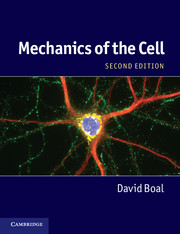Book contents
- Frontmatter
- Contents
- Preface
- List of symbols
- 1 Introduction to the cell
- 2 Soft materials and fluids
- Part I Rods and ropes
- Part II Membranes
- Part III The whole cell
- Appendix A Animal cells and tissues
- Appendix B The cell’s molecular building blocks
- Appendix C Elementary statistical mechanics
- Appendix D Elasticity
- Glossary
- References
- Index
Appendix A - Animal cells and tissues
Published online by Cambridge University Press: 05 June 2012
- Frontmatter
- Contents
- Preface
- List of symbols
- 1 Introduction to the cell
- 2 Soft materials and fluids
- Part I Rods and ropes
- Part II Membranes
- Part III The whole cell
- Appendix A Animal cells and tissues
- Appendix B The cell’s molecular building blocks
- Appendix C Elementary statistical mechanics
- Appendix D Elasticity
- Glossary
- References
- Index
Summary
Focusing on the mechanical operation of a cell, this text tends to emphasize aspects of structure and organization common to all cells. However, cells differ in many details according to their function, evolution and environment, such that, within a multicellular organism such as ourselves, there may be 100 or 200 different cell types. Because frequent reference is made to these cell types in the text, we provide in this appendix a brief survey of animal cells and their organization in tissues. Readers seeking more than this cursory introduction to cell biology should consult one of many excellent textbooks, such as Alberts et al. (2008), Goodsell (1993), or Prescott et al. (2004).
Tissues
Cells act cooperatively in a multicellular system, and are hierarchically organized into tissues, organs and organ systems. Tissues contain the cells themselves, plus other material such as the extracellular matrix secreted by the cells. Several different tissues may function together as an organ, usually with one tissue acting as the “skin” of the organ and providing containment for other tissues in the interior. Lastly, organs themselves may form part of an organ system such as the respiratory system. Animal tissues are categorized as epithelial, connective, muscle or nervous tissue, whose relationship within an organ (in this case the intestinal wall) is illustrated in Fig. A1.1. The intestine is bounded on the inside and outside by epithelial cell sheets (or epithelia), wherein epithelial cells are joined tightly to each other in order to restrict the passage of material out of the intestinal cavity. Connective tissue, which lies inside the boundaries provided by the epithelia, consists of fibroblastic cells that secrete an extracellular matrix which bears most of the stress in connective tissues. Lastly, several layers of smooth muscle tissue lie on the exterior of the connective tissue, in which they circle around the intestine (circular fibers) or run along its length (longitudinal fibers). Even a given cell type may exhibit several different forms, depending on the specific role that it plays. We now describe in more detail the four principal animal tissues.
- Type
- Chapter
- Information
- Mechanics of the Cell , pp. 525 - 530Publisher: Cambridge University PressPrint publication year: 2012



